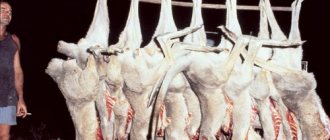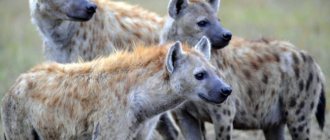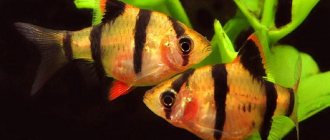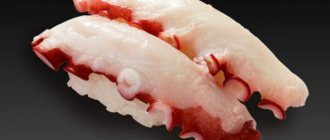Home page Wildlife Animal world
64 673 4.52 5
There is an opinion that friendly behavior can win a woman's heart much faster than a demonstration of strength. The male hyena understands this better than any other animal: since the females are the dominant ones in the pack, they get to decide who they want to be with - and they choose the best ones.
And the male, who is at a lower hierarchical level, can only wait - for some months, and for others years. If he is lucky and he can wait for the favor of the female, preferably the leader of the pack, then his status will increase, and he will become a leader among his own kind.
Therefore, when a female hyena passes by, he respectfully gives way to her, lowering his head as a sign of submission and pressing his ears, and if he notices that she is irritated, he quickly moves away.
Hyenas: general characteristics
These animals belong to the class of predatory mammals, and represent the hyena family. Interesting fact: hyenas belong to the order of felines, although, judging by their appearance, it would be more logical to assume their close relationship with dogs and wolves.
Hyenas are one of the most ancient predators on the planet
Spotted hyenas are the largest among their relatives. The height of these predators ranges from 70 to 85 cm, on average they weigh 45-70 kg, although the weight of some adults can reach up to 90 kg. The animals have a powerful, muscular body, thin but strong limbs, and a rounded head with a short, slightly pointed muzzle.
Due to the sloping lower part of the body, and the fact that the front legs of hyenas are longer than the hind legs, they look awkward, and even give the impression that the animal is limping when walking. But in fact, these are very dexterous and fast hunters who, thanks to their special physique, are able to reach speeds of up to 40-50 km per hour, covering long distances at this pace.
The body of spotted hyenas is covered with short, coarse hair. Their main color is grayish or light sandy, with brown spots scattered throughout the body. In the area of the nape, the fur has a reddish tint, the lower part of the jaw is dark gray, which, in contrast with the main light background, creates the effect of a “protective mask.”
Hyenas have powerful, well-developed jaws, with which they crush even the tibia bones of buffaloes, elephants and hippopotamuses. And the digestive tract of these predators is capable of digesting any food, including horns and hooves, so the carcass of any prey is eaten entirely by hyenas.
Spotted hyenas live in large packs, which is directly related to their natural habitat. After all, they coexist with other large predators, the same lions and leopards, which have always been their main food competitors. Only by combining their efforts to hunt and protect themselves from enemies, hyenas were able to survive for millions of years in the harsh places of the African continent. By the way, they do not feed exclusively on carrion, as is commonly believed, but are very dexterous and successful hunters.
In the wild, the lifespan of hyenas is no more than 12-15 years. In zoos, where they do not have to fight for their existence every day, they can live up to 20-25 years.
Elena
Ask a Question
Question to the expert
Is it true that hyenas are hermaphrodites?
No, this is another misconception related to the special structure of their genitals. For a long time, zoologists assumed that hyenas were indeed hermaphrodites, and that each individual possessed both male and female genitalia. Ancient legends generally say that hyenas can change gender at will. But when studying hyenas, scientists were able to establish the true reason for this myth. As it turned out, the male hormone testosterone predominates in the body of female spotted hyenas, as a result of which their external genitalia resemble the male genitals in shape and size.
№12
For a long time it was believed that they were hermaphrodites. All this is due to the altered genital organ of females, which is practically no different from the male. However, they are not hermaphrodites. These changes are caused by too much testosterone in the body of female hyenas.
As for the deformed genital organ, it greatly affects the life of females. Firstly, this makes it very difficult for them to mate. Secondly, childbirth for females is a real nightmare. Approximately 1 and 10 females die during childbirth. It's even worse with offspring. Most babies die from suffocation.
What do hyenas eat in the wild?
The contemptuous attitude towards hyenas is associated with their way of feeding, because they are considered eaters of dead flesh, and are even called “four-legged vultures.” And this is one of the most common misconceptions about hyenas. Yes, brown and striped hyenas eat mainly carrion, and their spotted relatives also never miss the opportunity to feast on the decomposing corpse of an animal. But at the same time, spotted hyenas are among the five most dangerous predators of the African savannas, and 90% of their food is obtained by hunting.
Population status
Until a certain point, the population of these incredible animals had a fairly wide habitat. Moreover, the size of the flocks could reach up to 100 individuals. Nowadays you rarely see a group of 20-30.
Raccoon dog: what it looks like, keeping it at home
As you can understand, the number of animals is gradually decreasing. The reason is mass shootings, changes in the conditions of their habitual habitat and infection with various diseases. Now this animal is included in the Red Book precisely because of its small numbers. In fact, wild dogs are on the verge of extinction.
Important! The total number of these animals today reaches about 3-5.5 thousand individuals. You can meet them in North and South Africa.
What do spotted hyenas hunt?
The victims of these predatory animals are mostly herbivorous ungulates:
- Wildebeest;
- Gazelles;
- Zebras;
- Buffaloes;
- Wild pigs are warthogs.
Hyenas are excellent hunters.
They also attack the cubs of such large African animals as giraffes and elephants. A pack of spotted hyenas is a formidable army, and they often take prey from their competitors: jackals, leopards and cheetahs. The only savannah predators that can resist hyenas are lions that are part of a pride. But a lone lioness or a maned male nomad more than once has to give up his rightful hunting trophy if their paths cross with a pack of spotted predators.
The fate of hyena victims is truly terrible. After all, if all predatory animals first kill their prey, and then begin to eat, then hyenas do not bother themselves with the merciful killing of their prey, but begin to eat it alive, tearing off huge pieces from the body beating in agony.
Hyena hunting methods
Spotted hyenas come out to hunt at night, resounding throughout the entire area with eerie giggles, groans and growls, the sound of which makes all the peaceful inhabitants of the African savannah shudder. The main female leads the procession, leading the entire clan, looking out for suitable prey along the way.
The method of hunting depends on the potential prey. If the pack encounters a single animal, all members, at a signal from the alpha female, simultaneously attack it, knocking it down. By the way, a spotted hyena can even cope with a large antelope alone, and these predators in a pack can easily knock down a large buffalo.
No herbivore stands a chance against a pack of hyenas
When hyenas hunt a group of ungulates, for example, zebras, they chase the herd, surrounding it with a crescent moon, and try to single out one individual from the total mass. As soon as the careless herbivore lags behind its relatives, the spotted predators immediately knock the victim to the ground, and its fate is sealed.
Hyenas are amazingly hardy and tenacious creatures. Zoologists who observed these animals in the wild noted that during hunting, hyenas sometimes do not have time to dodge hooves and horns. But, having received a powerful blow to the head with a hoof, causing the animal to somersault in the air, the hyena almost immediately rises to its feet and, as if nothing had happened, rushes into the attack again.
How do individuals reproduce?
The first experts who studied hyenas mistakenly considered them hermaphrodites. Such conclusions were based on the fact that animals have a unique structure of the reproductive system. This is what led to such a deep misconception. Female spotted hyenas and males have incredibly similar genitals. In the first few years of their life, it is generally impossible to determine gender. And only in the sixties of the twentieth century, scientists proved that predators have a specific gender, like all mammals.
Hyenas do not have a specific mating season; they can mate at any time of the year. Very often the breeding season coincides with the start of the rains.
The breeding process of the spotted hyena has its own characteristics. It is the males who begin their courtship first. They smell when females are ready to mate. If the female is favorable, the male bows his head low, thus expressing submission. He must receive approval, otherwise the female may choose a representative of another tribe. This happens quite often.
Reproduction and raising of offspring
Sexual maturity in spotted hyenas occurs when they reach 2 years of age. These animals do not have a specific mating season; theoretically, they are ready to mate all year round. But usually, breeding occurs during the rainy season, which in Africa lasts from November to March.
The male must show respect and deference to the female.
The signal for the start of the mating season is estrus in females. They mark their resting place and hind legs with a special odorous secretion secreted from the genitals. Having caught this smell, the males begin to fight among themselves for the right to mate. The winners express respect to their supreme rulers by approaching the females and servilely bowing their heads before them. If the female reacts favorably to the courtship of the gentleman, she gives permission for sexual intercourse.
To avoid degeneration, spotted hyenas choose to mate males who are not closely related to them. If there are no such in their native clan, females look for marriage partners from other groups located in the neighborhood.
Poll: do you think hyenas are disgusting and unattractive animals?
Yes, they have a terrible evil face and a terrible appearance.
17.65%
Yes, with their strange appearance they cause hostility and disgust.
5.88%
No, overall they are not that disgusting.
11.76%
No, they are very interesting, and their babies are generally quite cute creatures.
64.71%
Voted: 17
Duration of pregnancy and childbirth
The female spotted hyena carries her offspring for 14 weeks, and their pregnancy lasts just over 3 months in total. There are from 1 to 7 cubs in one litter, and their number depends on the age of the expectant mother. A more mature and experienced female gives birth to more babies, while young individuals have no more than 1-3 puppies in the litter.
Newborn hyenas are born sighted and with a full set of sharp teeth. And this is not without reason, because from the first minutes of their existence, the cubs begin a deadly struggle for survival. Moreover, the fight occurs between individuals of the same sex. If there are 2-3 females in the litter, only one of them will live. Small males also fight among themselves, but not so fiercely, and among them 1, rarely 2 cubs die.
Caring for young animals
Spotted hyenas raise their babies in a common burrow. The milk of these predators is very fatty and nutritious, and one feeding lasts the puppies for several days.
Hyenas are extremely caring mothers, but in their community it is not customary to raise cubs together. Each female loves and feeds only her own babies, and in the event of her death, her entire brood shares the sad fate of their mother.
Puppies feed on their mother's milk until they are one year old, but already in the third month of their life they begin to taste meat. By the way, when dividing the spoils, young babies have more rights than adult males and females from the lower hierarchy. The spotted head of the clan allows the cubs to approach the carcass, making sure that they are not driven away by other members of the pack.
Spotted hyena babies look like cute, harmless puppies
Grown-up females remain in their native clan, but males have a choice: stay with their family or go in search of a new group.
Elena
Ask a Question
Question to the expert
Is it possible to tame a hyena?
It is possible if you educate her practically from birth. If a hyena has lived surrounded by people since childhood, it is easily tamed and becomes very devoted to its owner. But adult individuals cannot be tamed. When brought to zoos as adults, hyenas, especially spotted ones, behave aggressively and mistrustfully, and react angrily to the presence of humans.
№14
Very often they are compared to wild dogs. However, they have no relationship (as we noted earlier) and, moreover, behave differently. Wild dogs (dingoes) care about the well-being of their pack. They will share the prey so that all members of their flock are well-fed and strong. In groups of hyenas everything is somewhat different. They will fight for food, trying to satisfy only their hunger. In the case of males and females, the latter can kill the former if they create problems for them.
We also recommend reading: Interesting facts about ladybugs
Natural enemies of hyenas
Among some African tribes there are legends that spotted hyenas can hypnotize any animal with one glance. Stories are also passed down from generation to generation that if the shadow of a hyena falls on any living creature, he freezes in place, and is unable to even move. If hyenas really possessed such magical abilities, then there would be no predators equal to them not only in Africa, but also on the entire planet.
The most hated and dangerous enemy of hyenas is the lion.
And so, in the wild, hyenas have plenty of enemies. And the most important enemy, with whom hyenas have been at odds for many millennia, is, of course, the king of beasts himself - the African lion. Huge cats will never miss the opportunity to take prey from hyenas, and spotted predators are left powerless to watch as lions devour the carcass of an ungulate that was so hard to hunt. The lion not only leaves the hyenas hungry, but also kills them for no particular reason. These cats have an inexplicable hatred for hyenas, and, having met a lone individual or young cubs, the lion will strangle them without hesitation.
Hyenas do not remain in debt, and in revenge they kill small lion cubs, as well as lonely sick lions. But in a confrontation between these animals, hyenas have almost no chance, because even one strong and healthy lion can drive away an entire pack of spotted predators from their prey.
The list of hyenas' competitors also includes hyena-like dogs, because these animals share the same habitat and hunt the same herbivores. Skirmishes often break out between a pack of dogs and a clan of hyenas over prey, and the winner is the one with the numerical advantage.
Hyenas also feud with hyena-like dogs
Another rival of these predators is their close relatives - brown hyenas. Meetings of clans of two relatives end in a fierce fight, in which the larger and stronger spotted hyenas usually win. But victory is not easy for them, because coastal hyenas have extremely powerful jaws and sharp teeth, with which they can crush the bones of an elephant, and after the battle, many members of the pack are left with bleeding wounds and battle scars.
Features of behavior
Hyenas have unique sound characteristics. The terrible laughter that terrifies people is not a mockery, but just a joyful announcement to one’s clan about the discovery of food. Such a cry is often answered not only by family members, but also by enemies - lions. Therefore, they often have to leave with nothing and look for other places for food.
Hyenas are very important animals. They are real orderlies of the African savannahs. Nature has endowed them with rare resistance to various microorganisms. For example, in the 80s there was an anthrax outbreak, 4 thousand hippos died. The hyenas ate the infected corpses, stopping the further spread of the epidemic. Thanks to their unique jaws and stomach, they can chew and eat horns, hooves, and skeletons of dead animals, thereby clearing the African savannas of garbage.
At the ends of hyenas' paws there are glands that produce a disgusting-smelling secretion. By smell, predators cleverly identify individuals of their clan.











